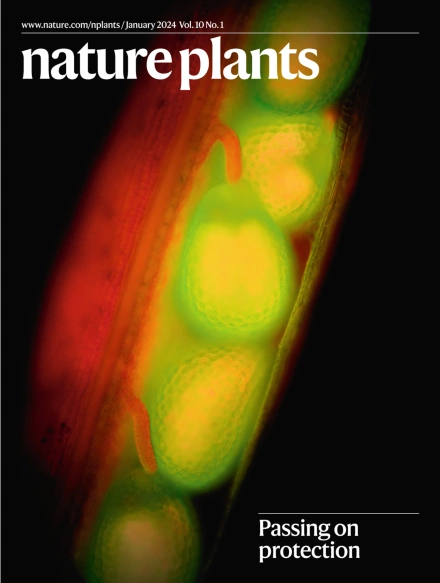一个保守的疫霉胞外胰蛋白酶样丝氨酸蛋白酶靶向受体样激酶BAK1来抑制植物免疫
IF 13.6
1区 生物学
Q1 PLANT SCIENCES
引用次数: 0
摘要
植物细胞表面模式识别受体(PRRs)对微生物病原体的感知激活了植物的模式触发免疫(PTI)。受体样激酶BAK1作为许多PRRs的共受体,是PTI信号转导的中枢免疫调节剂。然而,微生物病原体通过操纵外质体中的BAK1来克服这层免疫的分子机制在很大程度上仍然未知。在本研究中,我们大规模筛选了抑制疫霉菌激菌素INF1引发的细胞死亡的疫霉菌胞外效应物,并鉴定出一种胞外胰蛋白酶样丝氨酸蛋白酶PsTry1。PsTry1在大豆和benthamiana中与BAK1结合,广泛抑制不同MAMPs引发的免疫反应。进一步研究发现,PsTry1可切割大豆GmBAK1的胞外结构域,PsTry1抑制植物免疫的能力取决于其蛋白水解活性。广泛的Ala置换突变筛选显示,GmBAK1的Leu163是PsTry1切割所必需的关键残基。此外,PsTry1在疫霉病原菌中高度保守,多个同源物能够通过裂解BAK1抑制PTI。总的来说,这项研究揭示了植物病原体利用一种新的策略来抑制植物的胞外免疫。本文章由计算机程序翻译,如有差异,请以英文原文为准。


A conserved Phytophthora apoplastic trypsin-like serine protease targets the receptor-like kinase BAK1 to dampen plant immunity
Perception of microbial pathogens by plant cell-surface pattern recognition receptors (PRRs) activates pattern-triggered immunity (PTI) in plants. The receptor-like kinase BAK1 functions as co-receptor of many PRRs and is a central immune regulator in PTI signal transduction. However, the molecular mechanism by which microbial pathogens manipulate BAK1 in the apoplast to overcome this layer of immunity remains largely unknown. In this study, we performed a large-scale screening of Phytophthora apoplastic effectors suppressing cell death triggered by Phytophthora elicitin INF1 and identified an apoplastic trypsin-like serine protease PsTry1. PsTry1 associates with BAK1 in soybean and N. benthamiana, and widely suppresses immune response triggered by different MAMPs. Further study revealed that PsTry1 cleaves the extracellular domain of soybean GmBAK1 and the ability of PsTry1 to suppress plant immunity depends on its proteolysis activity. An extensive Ala substitution mutagenesis screen revealed that Leu163 of GmBAK1 is a key residue essential for PsTry1 cleavage. Furthermore, PsTry1 is highly conserved among Phytophthora pathogens and multiple homologues are capable of suppressing PTI through cleavage of BAK1. Collectively, this study reveals a novel strategy exploited by phytopathogens to suppress plant apoplastic immunity. Phytophthora secretes a conserved trypsin-like serine protease, PsTry1, that suppresses apoplastic immunity by cleaving the extracellular domain of the co-receptor BAK1, revealing a novel mechanism by which pathogens overcome apoplastic immune defences.
求助全文
通过发布文献求助,成功后即可免费获取论文全文。
去求助
来源期刊

Nature Plants
PLANT SCIENCES-
CiteScore
25.30
自引率
2.20%
发文量
196
期刊介绍:
Nature Plants is an online-only, monthly journal publishing the best research on plants — from their evolution, development, metabolism and environmental interactions to their societal significance.
 求助内容:
求助内容: 应助结果提醒方式:
应助结果提醒方式:


